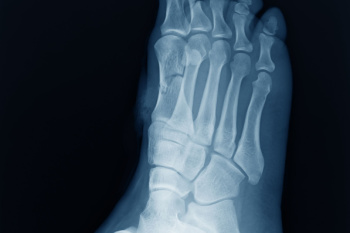
The cuboid bone may be small, but it plays a big role in foot function. Located on the outer midfoot, it acts as a stabilizer, supporting weight distribution and aiding movement. It also helps maintain the arch and provides a smooth transition when walking. Because of its key position, even minor misalignment can lead to pain and mobility issues. One common problem is cuboid syndrome, where the bone shifts out of place due to overuse, injury, or wearing tight footwear. This can cause sharp pain along the outer foot, stiffness, and difficulty bearing weight. Dancers, athletes, and people with flat feet are especially at risk. Ignoring symptoms can lead to chronic discomfort and changes in gait. Treatment includes rest, foot strengthening, and sometimes realignment techniques. If you are experiencing this type of pain and it persists or worsens, it is suggested that you see a podiatrist to restore proper function and prevent further issues.
Cuboid syndrome, also known as cuboid subluxation, occurs when the joints and ligaments near the cuboid bone in the foot become torn. If you have cuboid syndrome, consult with the foot specialists from Academy Foot and Ankle Specialists. Our doctors will assess your condition and provide you with quality foot and ankle treatment.
Cuboid syndrome is a common cause of lateral foot pain, which is pain on the outside of the foot. The condition may happen suddenly due to an ankle sprain, or it may develop slowly overtime from repetitive tension through the bone and surrounding structures.
Causes
The most common causes of cuboid syndrome include:
- Injury – The most common cause of this ailment is an ankle sprain.
- Repetitive Strain – Tension placed through the peroneus longus muscle from repetitive activities such as jumping and running may cause excessive traction on the bone causing it to sublux.
- Altered Foot Biomechanics – Most people suffering from cuboid subluxation have flat feet.
Symptoms
A common symptom of cuboid syndrome is pain along the outside of the foot which can be felt in the ankle and toes. This pain may create walking difficulties and may cause those with the condition to walk with a limp.
Diagnosis
Diagnosis of cuboid syndrome is often difficult, and it is often misdiagnosed. X-rays, MRIs and CT scans often fail to properly show the cuboid subluxation. Although there isn’t a specific test used to diagnose cuboid syndrome, your podiatrist will usually check if pain is felt while pressing firmly on the cuboid bone of your foot.
Treatment
Just as the range of causes varies widely, so do treatments. Some more common treatments are ice therapy, rest, exercise, taping, and orthotics.
If you have any questions, please feel free to contact our offices located in Southlake, Keller (Fort Worth), Hurst, North Richland Hills, Flower Mound, Argyle, and Denton, TX. . We offer the newest diagnostic and treatment technologies for all your foot care needs.
